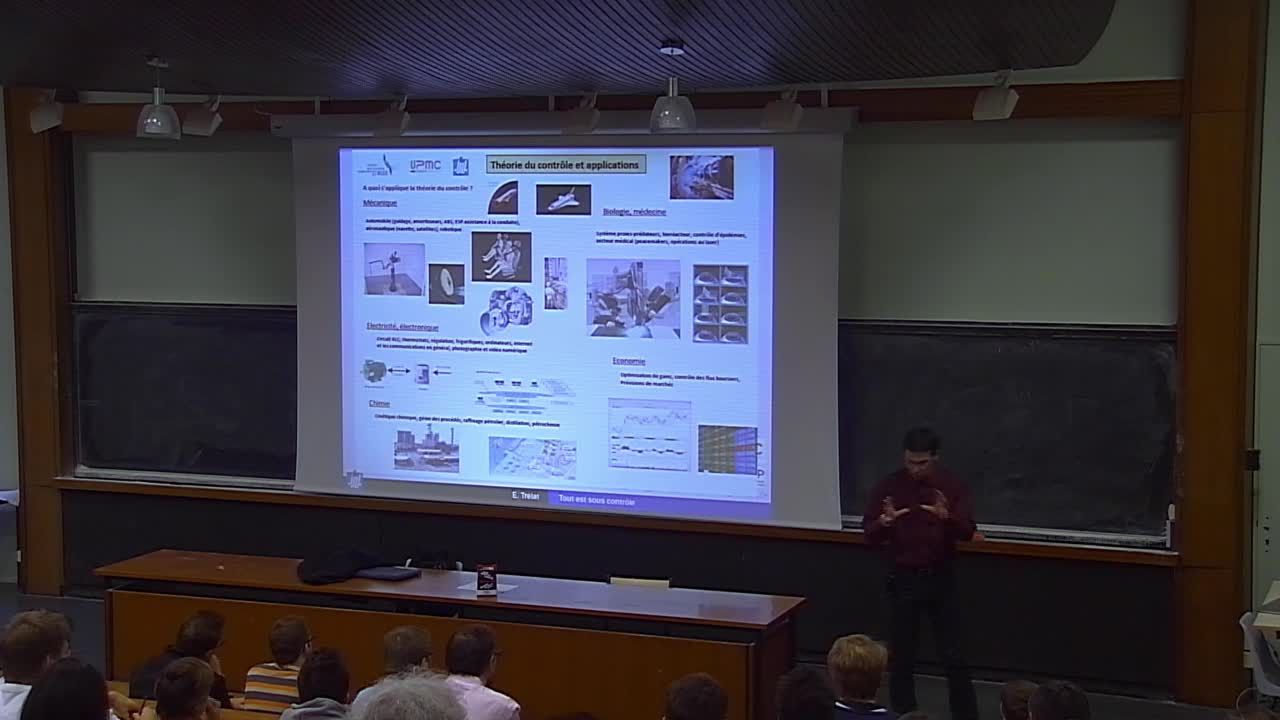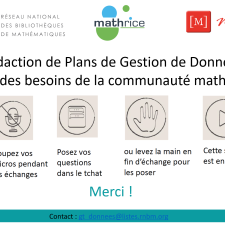Notice
Emmanuel Trélat - Théorie du contrôle optimal et applications aux missions spatiales
- document 1 document 2 document 3
- niveau 1 niveau 2 niveau 3
Descriptif
La problématique du contrôle optimal est de guider l'évolution en temps d'un système donné vers une configuration finale souhaitée, tout en minimisant un certain critère. Le point saillant de cette théorie, qui généralise le calcul des variations, est le principe du maximum de Pontryagin, qui donne des conditions nécessaires d'optimalité du premier ordre. Du point de vue numérique ce principe réduit le problème initial à un problème aux deux bouts qui peut être résolu par une méthode de tir.
En pratique il est très difficile de faire converger numériquement une méthode de tir, et elle doit être combinée à d'autres approches. Je parlerai ici, sur des exemples motivés par l'aérospatiale, des méthodes de continuation numérique, de contrôle géométrique, puis d'éléments de théorie des systèmes dynamiques qui, convenablement utilisés, permettent de planifier des missions spatiales interplanétaires.
Thème
Documentation
Liens
Avec les mêmes intervenants et intervenantes
-
Emmanuel Trélat - Tout est sous contrôle
TrélatEmmanuelSéminaire du magistère de math 13 octobre 2016
-
Emmanuel Trelat - Analyse spectrale des Laplaciens sous-Riemanniens, mesure de Weyl
TrélatEmmanuelDans une série de travaux avec Yves Colin de Verdière et Luc Hillairet, nous étudions les propriétés spectrales des Laplaciens sous-Riemanniens, qui sont des opérateurs hypoelliptiques. L'objectif
Sur le même thème
-
Tuan Ta Pesao : écritures de sable et de ficelle à l'Ile d'Ambrym
VandendriesscheEricCe film se déroule au Nord de l’île d’Ambrym, dans l’archipel de Vanuatu, en Mélanésie...
-
"Le mathématicien Petre (Pierre) Sergescu, historien des sciences, personnalité du XXe siècle"
HerléaAlexandreAlexandre HERLEA est membre de la section « Sciences, histoire des sciences et des techniques et archéologie industrielle » du CTHS. Professeur émérite des universités, membre effectif de l'Académie
-
Webinaire sur la rédaction des PGD
LouvetViolaineRédaction des Plans de Gestion de Données (PGD) sous l’angle des besoins de la communauté mathématique.
-
Alexandre Booms : « Usage de matériel pédagogique adapté en géométrie : une transposition à interro…
« Usage de matériel pédagogique adapté en géométrie : une transposition à interroger ». Alexandre Booms, doctorant (Université de Reims Champagne-Ardenne - Cérep UR 4692)
-
R. Bamler - Compactness and partial regularity theory of Ricci flows in higher dimensions
BamlerRichard H.We present a new compactness theory of Ricci flows. This theory states that any sequence of Ricci flows that is pointed in an appropriate sense, subsequentially converges to a synthetic flow.
-
P. Burkhardt - Pointwise lower scalar curvature bounds for C0 metrics via regularizing Ricci flow
Burkhardt-GuimPaulaWe propose a class of local definitions of weak lower scalar curvature bounds that is well defined for C0 metrics. We show the following: that our definitions are stable under greater-than-second
-
C. Li - Classifying sufficiently connected PSC manifolds in 4 and 5 dimensions
LiChaoIn this talk, I will discuss some recent developments on the topology of closed manifolds admitting Riemannian metrics of positive scalar curvature. In particular, we will prove if a closed PSC
-
T. Ozuch - Noncollapsed degeneration and desingularization of Einstein 4-manifolds
OzuchTristanWe study the noncollapsed singularity formation of Einstein 4-manifolds. We prove that any smooth Einstein 4-manifold close to a singular one in a mere Gromov-Hausdorff (GH) sense is the result
-
D. Tewodrose - Limits of Riemannian manifolds satisfying a uniform Kato condition
TewodroseDavidPresentation of a joint work with G. Carron and I. Mondello where we study Kato limit spaces.
-
Y. Lai - A family of 3d steady gradient Ricci solitons that are flying wings
LaiYiWe find a family of 3d steady gradient Ricci solitons that are flying wings. This verifies a conjecture by Hamilton. For a 3d flying wing, we show that the scalar curvature does not vanish at
-
A. Mondino - Time-like Ricci curvature bounds via optimal transport
MondinoAndreaThe goal of the talk is to present a recent work in collaboration with Cavalletti (SISSA) on optimal transport in Lorentzian synthetic spaces. The aim is to set up a “Lorentzian analog” of the
-
M. Lesourd - Positive Scalar Curvature on Noncompact Manifolds and the Positive Mass Theorem
LesourdMartinThe study of positive scalar curvature on noncompact manifolds has seen significant progress in the last few years. A major role has been played by Gromov's results and conjectures, and in















